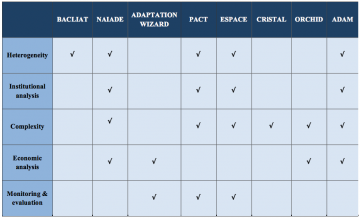Exploring tools from their ANALYTICAL SCOPE

This page explains the main findings of the review in terms of the analytical scope of the tools. The table illustrates how well the reviewed adaptation tools cover aspects such as heterogeneity, complexity, institutional change, economic analysis, and monitoring. You can find different examples of how tools cover these aspects and a summary of the main findings for each aspect below.

Download table
Heterogeneity
Example: NAIADE: using multi-criteria analysis to address water issues
Heterogeneity relates to differential exposure units.
Different units (for example a household, or a livelihood, or a particular group of persons) have different exposure to climate and other risks. Heterogeneity captures these differences.
Although some tools recognize multiple units, most non-process based tools do not seem to address differential exposure units. This means that in most of the cases the methods will need to be repeated for each group/unit of analysis. This makes it more difficult to analyze and deduce interactions between groups/units unless this process is systematically designed to be repeated amongst the range of actor groups.
Institutional analysis
Example: PACT: helping companies assess their strategic exposure to climate risks
Socio-institutional change and networks drive and bound adaptation.
Organisational capacity for change and recommendations for how to achieve this are addressed in detail by process-based tools such as PACT and ESPACE, and to a much lesser extent by simpler tools such as BACLIAT. On the other hand, PACT probably has a slightly steeper learning curve and is more focussed on operationalising and implementation than awareness-raising alone (though awareness-raising is achieved as a by-product of the process involved).
UPDATE: Please note that PACT has been superseeded by CaDD.
Complexity
Example: ORCHID: screening climate risks to development cooperation in India
Complexity relates to how multiple stresses interact, considering not just climate related ones.
As the field of climate adaptation has evolved, multiple stresses are captured to some extent by some tools, but often not in a way that is not driven by climate, or in a way that does not go beyond filling out a checklist.
In-depth narrative analysis, for example, which would uncover many types of social or socio-institutional stresses, and the interaction of both bio-physical and social factors, is often missing. This also means that cross-sector analysis is often missing from the actual tool and relies on further interpretation by the tool user/researcher.
Economic analysis
Example: ADAM: a macro-economic analysis and an adaptation catalogue of adaptation options in Europe
Economic analysis relates to some estimation of economic cost and benefits of adaptation.
While economic methods are included by some tools, such as ORCHID, the goal of which is project screening, those whose goal may be more implementation oriented, such as CRiSTAL or PACT do seem not to cover them as much. ADAM also covers economic aspects through a macro-economic analysis of climate change and adaptation in Europe. In general, there seems to be major data constraints in analysing non-structural measures as compared to infrastructural measures.
Monitoring & evaluation
Example: ESPACE: monitoring and evaluating organizational change to address climate change challenges
Process-based tools like ESPACE and PACT can be applied to monitor behavioral change of individuals and organizations needed to adopt a more pro-active role in tackling the challenges brought by climate change. These tools are based on response levels that are assessed for different aspects of the change required to increase adaptive capacity. Other tools like the UKCIP Wizard could also be used for monitoring change, emphasising the adaptive approach to managing climate change and the need to revisit decisions in light of new information.
View our
Case studies: Analytical scope lens
Review of Adaptation Decision Tools
Introduction: Reviewing of adaptation decision tools
Reviewing tools that use a bottom-up approach & recommendations
PACT (Note: this tool has been superseeded by CaDD)
Conditions of Applicability
Case Studies
(0) Comments
There is no content